the Creative Commons Attribution 4.0 License.
the Creative Commons Attribution 4.0 License.
New shell information and new generic attributions for the Egyptian podocnemidid turtles “Podocnemis” fajumensis (Oligocene) and “Podocnemis” aegyptiaca (Miocene)
The early Oligocene “Podocnemis” fajumensis and the early Miocene “Podocnemis” aegyptiaca are two podocnemidid turtles from northern Egypt, defined more than a century ago. Their identification as representatives of the South American genus Podocnemis cannot currently be supported. Relatively limited information on both species was available. In fact, no photograph on the shell of either of them has been published so far, and the type material of both is currently lost. Shell remains of almost 15 specimens of “Podocnemis” fajumensis are analyzed here, including a complete carapace and two complete plastra. A neotype is designated here for the species. An artificial mold of the holotype of “Podocnemis” aegyptiaca is identified, corresponding to its holoplastotype. Both “Podocnemis” fajumensis and “Podocnemis” aegyptiaca are confirmed as valid species, attributable to Erymnochelyini, a clade currently exclusively represented by the Malagasy Erymnochelys madagascariensis. A new diagnosis is proposed for each of these extinct species, including both autapomorphies and a unique combination of characters. They are attributed to two new genera, corresponding to the oldest defined for the African record of Erymnochelyini. Thus, the new combinations Shetwemys fajumensis (http://zoobank.org/NomenclaturalActs/B4805343-8533-4DA7-808B-BB972D4471CB, urn:lsid:zoobank.org:act:B4805343-8533-4DA7-808B-BB972D4471CB) and Apeshemys aegyptiaca (http://zoobank.org/NomenclaturalActs/43DD73CF-AAED-47A0-9FFB-EB6CFB80D389, urn:lsid:zoobank.org:act:43DD73CF-AAED-47A0-9FFB-EB6CFB80D389) are proposed.
Podocnemis Wagler, 1830 is a genus of pleurodiran turtles exclusive to the northern area of South America, where it is recognized by six extant species (i.e., Podocnemis expansa (Schweigger, 1812), Podocnemis erythrocephala (von Spix, 1824), Podocnemis unifilis Troschel, 1848, Podocnemis sextuberculata Cornalia, 1849, Podocnemis lewyana Duméril, 1852, and Podocnemis vogli Müller, 1935) (Rhodin et al., 2017), as well as by an extinct form, the Peruvian Podocnemis bassleri Williams, 1956, probably from the late Miocene (see Gaffney et al., 2011, and references therein). Podocnemis was the first defined genus of the diverse clade Podocnemididae. In fact, this genus was used as a wastebasket taxon, so that several American extant (e.g., the podocnemidid Peltocephalus dumerilianus (Schweigger, 1812), recognized as a representative of Podocnemis by Siebenrock (1902)) and extinct species (e.g., the members of Bothremydidae Chedighaii barberi (Schmidt, 1940), from the Late Cretaceous of United States, and Motelomama olssoni (Schmidt 1931), from the early Eocene of Peru; those of Podocnemididae Bauruemys elegans (Suárez, 1969), from the Late Cretaceous of Brazil, and Bairdemys venezuelensis (Wood and Díaz de Gamero, 1971), from the late Miocene of Venezuela; all of them identified as belonging to Podocnemis when they were defined), currently recognized as belonging to other genera of Podocnemididae and even to forms not corresponding to this clade, were attributed to it.
The putative identification of the genus Podocnemis was also reported outside the American continent, through several species. One of the main regions where several extinct species were originally defined as members of Podocnemis was Africa. Thus, the bothremydid Taphrosphys congolensis (Dollo, 1913), from the middle to upper Paleocene of Angola, was originally established as a representative of Podocnemis (see Pérez-García et al., 2020); the poorly known “Podocnemis” somaliensis Walker, 1966, from the middle Eocene of Somalia, is currently identified as a member of Bothremydidae, of uncertain generic assignment, rather than being recognized as a podocnemidid (see Gaffney et al., 2006). The podocnemidid Cordichelys antiqua (Andrews, 1903), from the late Eocene of Egypt, was originally defined as a member of Podocnemis; “Podocnemis stromeri” von Reinach, 1903a, from the same locality and age, is currently recognized as a junior synonym of it (see Gaffney et al., 2011, and references therein). The pocnemidids “Podocnemis” podocnemoides Reinach, 1903b, from the late Eocene of Egypt, and “Podocnemis” bramlyi Fourteau, 1920, from the early Miocene of Egypt, are poorly known forms, not attributable to the genus Podocnemis and considered in some recent works as nomina dubia (see Gaffney et al., 2011). The putative identification of some African species as attributable to Podocnemis not only affected extinct taxa. Thus, the extant Erymnochelys madagascariensis (Grandidier, 1867), which is the only representative of Erymnochelyini (Erymnochelyinae, Podocnemididae) that is part of the current biodiversity (Pérez-García et al., 2021), was also considered attributable to Podocnemis (Boettger, 1893; Dacqué, 1912).
Two extinct African species of Erymnochelyini were also defined as representatives of Podocnemis, but they are currently recognized as not attributable to any defined genus (Pérez-García and de Lapparent de Broin, 2015; Pérez-García et al., 2017). One of them is “Podocnemis” fajumensis Andrews, 1903, from the early Oligocene of Egypt, now identified as the senior synonym of “Podocnemis blanckenhorni” Reinach, 1903b. “Podocnemis” fajumensis is recognized both for abundant shell remains and for several well-preserved skulls. Although Gaffney et al. (2011) considered that it could belong to a member of the European Eocene genus Neochelys Bergounioux, 1954, this hypothesis was subsequently refuted (see Pérez-García and de Lapparent de Broin, 2015). Thus, its attribution to Erymnochelyini, proposed by Lapparent de Broin (2000), was confirmed, but the definition of a new genus for it has not been carried out so far (Pérez-García and de Lapparent de Broin, 2015; Pérez-García et al., 2017, 2021). The second species is “Podocnemis” aegyptiaca Andrews, 1900, from the early Miocene of Egypt. Although this species appears to be valid, both the shell by which it was defined (see Andrews, 1900) and a second shell indisputably attributable to it – which allows confirmation of the unique morphology of the vertebral scutes of this taxon (see Fourteau, 1920) – are currently considered lost (see Gaffney et al., 2011). The graphic information available up to now on these remains has been very limited, being exclusively based on drawings (see plate 1 in Andrews, 1900, fig. 21 in Fourteau, 1920), but not on photographs. Therefore, the characters used for its characterization could not be confirmed, and relevant anatomical regions for the comparison between the shells of the members of Erymnochelyini (e.g., the visceral region of the anterior plastral lobe), preserved but not figured for the specimen used to define this species, were hitherto unknown.
Although the presence of Erymnochelyini is known in the African record from the Upper Cretaceous (Gaffney and Forster, 2003; Pérez-García et al., 2017, 2021), no genus of this lineage has been established on that continent at levels older than the latest Miocene (see fig. 1 in Pérez-García et al., 2017). A cast of the shell by which Andrews (1900) defined the species “Podocnemis” aegyptiaca has been identified in the Natural History Museum (London) and is analyzed here. The first-hand study of abundant postcranial remains of “Podocnemis” fajumensis, deposited in various European and North American institutions, is also carried out. These specimens correspond to those previously known as well as to several unpublished. Thus, the shells of both taxa are figured in detail, and their characters are here compared with those of the other members of Erymnochelyini, a lineage for which information on the shell has markedly improved in recent years (Pérez-García et al., 2017, 2021; Pérez-García and Chapman, 2017; Pérez-García and Smith, 2017; Georgalis et al., 2020). Both “Podocnemis” fajumensis and “Podocnemis” aegyptiaca are confirmed here as two valid species, corresponding to Erymnochelyini. The diagnoses of both taxa are amended, considering the current knowledge about the members of this group and incorporating character states hitherto not considered for these species. As a consequence, two new genera of Erymnochelyini are defined, corresponding to the oldest in the African record.
Institutional abbreviations
AMNH, American Museum of Natural History, New York, USA; CGM, Cairo Geological Museum, Egypt; DPC, Duke Primate Center, Duke University, Durham, North Carolina, USA; NHMUK, Natural History Museum, London, UK; SMNS, Staatliches Museum für Naturkunde Stuttgart, Germany; YPM Yale Peabody Museum, New Haven, Connecticut, USA.
Anatomical abbreviations
Ab, abdominal; An, anal; axb, axillary buttress; axs, axillary scar; c, costal; Eg, extragular; en, entoplastron; ep, epiplastron; Fe, femoral; Gu, gular; hp, hypoplastron; Hu, humeral; hy, hyoplastron; ils, iliac scar; ins, inguinal scar; iss, ischial scar; M, marginal; ms, mesoplastron; n, neural; nu, nuchal; p, peripheral; Pc, pectoral; Pl, pleural; pus, pubic scar; py, pygal; sp, suprapygal; V, vertebral; xi, xiphiplastron.
-
Testudines Batsch, 1788
-
Pleurodira Cope, 1864
-
Pelomedusoides Cope, 1868
-
Podocnemidoidea Cope, 1868
-
Podocnemididae Cope, 1868
-
Erymnochelyinae Broin, 1988
-
Erymnochelyini Pérez-García, Díaz-Berenguer, Badiola and Canudo, 2021
Shetwemys gen. nov.
Figs. 1–4
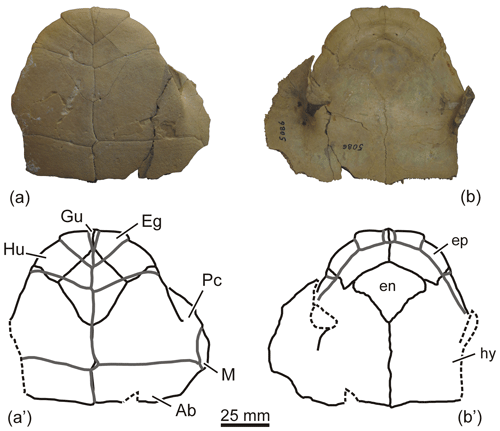
Figure 1AMNH 5086, neotype of the podocnemidid turtle Shetwemys fajumensis comb. nov. (Erymnochelyini), from the lower Oligocene (Rupelian) of the Fayum Depression (Fayum Governorate, northern Egypt), in ventral (a) and dorsal (b) views.
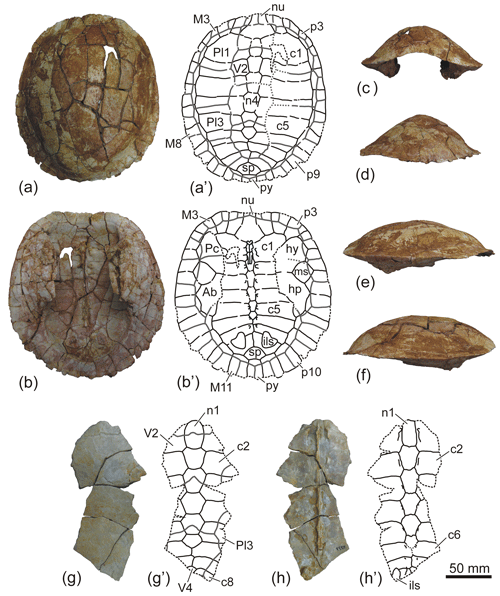
Figure 2Shell remains of the podocnemidid turtle Shetwemys fajumensis comb. nov. (Erymnochelyini), from the lower Oligocene (Rupelian) of the Fayum Depression (Fayum Governorate, northern Egypt). (a–f) AMNH 5087, carapace and partial plastron, in dorsal (a), ventral (b), anterior (c), posterior (d), left lateral (e), and right lateral (f) views. (g–h) SMNS 11233/1, partial carapace, in dorsal (g) and ventral (h) views.
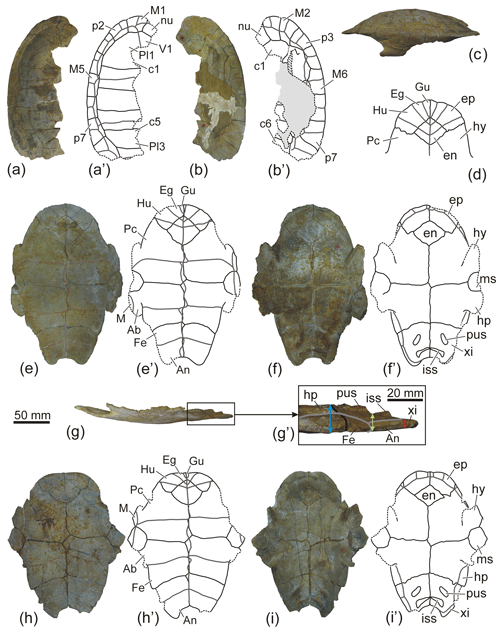
Figure 3Shell remains of the podocnemidid turtle Shetwemys fajumensis comb. nov. (Erymnochelyini), from the lower Oligocene (Rupelian) of the Fayum Depression (Fayum Governorate, northern Egypt). (a–c) SMNS 11233/2, partial carapace, in dorsal (a), ventral (b), and left lateral (c) views. (d) Ventral view of the anterior lobe the holotype of the species, currently lost, based on the fig. 2C in plate 8 of Andrews (1903). (e–g) SMNS 12647, plastron, in ventral (e), dorsal (f), and left lateral (g) views. (g') corresponds to an enlarged photograph of the posterior plastral lobe, in left lateral view, in which the thickness in the regions close to the hypo-xiphiplastral suture (in blue), between the pelvic scars (in green), and at the level of the anal notch (in red), have been represented by arrows (h–i), SMNS 12646, plastron, in ventral (h) and dorsal (i) views.
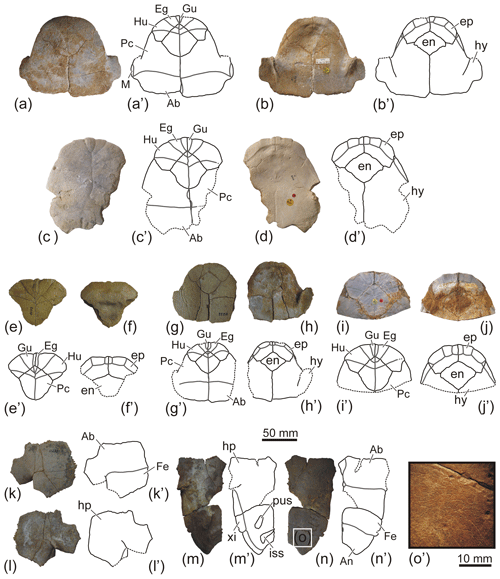
Figure 4Plastral remains of the podocnemidid turtle Shetwemys fajumensis comb. nov. (Erymnochelyini), from the lower Oligocene (Rupelian) of the Fayum Depression (Fayum Governorate, northern Egypt). (a–b) NHMUK R3435, anterior plastral lobe, in ventral (a) and dorsal (b) views. (c–d) NHMUK R8441, plaster cast of the specimen CGM C8509, anterior plastral lobe, in ventral (c) and dorsal (d) views. (e–f) AMNH 5093, articulated epiplastra and entoplastron, in ventral (e) and dorsal (f) views. (g–h) SMNS 11233/6, anterior plastral lobe, in ventral (g) and dorsal (h) views. (i–j) NHMUK R3103, partial anterior plastral lobe, in ventral (i) and dorsal (j) views. (k–l) SMNS 11233/5, right hypoplastron, in ventral (k) and dorsal (l) views. (m–n) SMNS 11233/3, articulated left hypoplastron and xiphiplastron, in dorsal (m) and ventral (n) views, and detail of the outer ornamental pattern (o).
Type and only included species
Shetwemys fajumensis (Andrews, 1903).
Etymology
This generic name is composed of the prefix Shetw- (ancient Egyptian), meaning turtle, and the suffix -emys (Greek), referring to freshwater turtle.
Type locality and horizon
North of Lake Qarun, Fayum Depression, Fayum Governorate, northern Egypt. Jebel el-Quatrani Formation, early Oligocene (Rupelian) (Andrews, 1903; Gaffney et al., 2011; Pérez-García et al., 2017).
Distribution
Early Oligocene of the Fayum Depression (Egypt).
Diagnosis
As for the type and only known species.
-
Shetwemys fajumensis (Andrews, 1903) comb. nov.
Figs. 1–4
-
Podocnemis fajumensis Andrews (1903), Fourteau (1920)
-
Podocnemis blanckenhorni Reinach (1903b)
-
Podocnemis blanckenhorni var. ovata Reinach (1903b)
-
Erymnochelys fajumensis Broin (1977)
-
aff. Erymnochelys fajumensis Lapparent de Broin (2000)
-
Neochelys fajumensis Gaffney et al. (2011)
-
“Neochelys” fajumensis Pérez-García and de Lapparent de Broin (2015), Ferreira et al. (2018), Lapparent de Broin et al. (2020)
-
“Podocnemis” fajumensis Pérez-García et al. (2017), Pérez-García (2019)
Type material
Andrews (1903) figured, by a schematic drawing (see Fig. 3d, as well as fig. 2C in plate 8 of Andrews, 1903), the anterior lobe of an individual that he identified as the type specimen. It is currently lost. Therefore, a neotype is designated here, also corresponding to an anterior plastral lobe: AMNH 5086 (Fig. 1a–b; see also fig. 86B in Gaffney et al., 2011, corresponding to a partial drawing of its ventral view).
Other specimens attributed to this taxon
AMNH 5087, carapace and partial plastron (Fig. 2a–f; previously cited by Gaffney et al., 2011, but so far not figured); SMNS 11233/1, partial carapace (Fig. 2g–h); SMNS 11233/2, partial carapace (Fig. 3a–c); SMNS 12647, plastron (Fig. 3e–g); SMNS 12646, plastron (Fig. 3h–i); NHMUK R3435, anterior plastral lobe (Fig. 4a–b; previously cited by Gaffney et al., 2011, but so far not figured); CGM C8509, anterior plastral lobe (see Fig. 4c–d, corresponding to a plaster cast of the specimen, NHMUK R8441); AMNH 5093, articulated epiplastra and entoplastron (Fig. 4e–f; fig. 86D in Gaffney et al., 2011, corresponding to a drawing of the external view); SMNS 11233/6, anterior plastral lobe (Fig. 4g–h); NHMUK R3103, partial anterior plastral lobe (Fig. 4i–j; previously cited by Gaffney et al., 2011, but so far not figured); SMNS 11233/5, right hypoplastron (Fig. 4k–l); SMNS 11233/3, articulated left hypoplastron and xiphiplastron (Fig. 4m–n); specimen without number, and currently lost, corresponding to the anterior plastral lobe identified by von Reinach (1903b) as the type specimen of Podocnemis blanckenhorni (see figs. 1 and 2 in the plate 9 of von Reinach (1903b), corresponding to the drawings of the dorsal and ventral views of the specimen); specimen without number, and currently lost, corresponding to the anterior plastral lobe identified by von Reinach (1903b) as the type specimen of Podocnemis blanckenhorni var. ovata (see figs. 3 and 4 in the plate 9 of von Reinach (1903b), corresponding to the drawings of the dorsal and ventral views of the specimen); DPC 3146, skull (see figs. 44–45 in Gaffney et al., 2011); DPC 99–245, skull (see fig. 46 in Gaffney et al., 2011). Furthermore, Gaffney et al. (2011) cited other specimens as attributable to this species, but they remain unpublished (their attribution to this taxon should be confirmed by their study and figuration). They correspond to complete and partial shells (CGM 8790, DPC 2149, DPC 2491, DPC 4605, DPC 6209, DPC 7747, DPC 9483, DPC 10434, DPC 10686, YPM 6202-6203), complete and partial skulls (DPC 1697, DPC 3882, DPC 12143, DPC 15310), and complete and partial lower jaws (DPC 1699, DPC 2003, DPC 2223, DPC 2230, DPC 2602, DPC 2747, DPC 2754, DPC 2779, DPC 2858, DPC 3249, DPC 3261, DPC 3308, DPC 3442, DPC 3862, DPC 3973, DPC 4291, DPC 4400, DPC 4413, DPC 4495, DPC 5068, DPC 5193, DPC 5520, DPC 5749, DPC 5786, DPC 5892, DPC 6205, DPC 6413, DPC 6522, DPC 6558, DPC 7331, DPC 7545-7546, DPC 7673, DPC 9352A, DPC 9795, DPC 10226, DPC 10382, DPC 10607, DPC 11192, DPC 11403, DPC 12116).
Diagnosis
Member of the lineage of Podocnemididae Erymnochelyini considering the medial contact of the extragulars, posteriorly to the reduced gular that they frame. It is defined by the following characters recognized as exclusive within this clade: thickening in the visceral plastral area, close to the hypo-xiphiplastral sutures; broad dorsal expansion of the plastral scutes; anteriorly directed and well-developed medial protrusion in the prefrontals–frontals suture. It shows the following unique combination of characters: absence of carapacial medial keel; six neurals; medial contact of the sixth to eighth pairs of costals; heptagonal first vertebral, with short latero-anterior margins, and wider than the nuchal; sub-equal width of the second and third vertebrals, with sub-straight lateral margins, their maximum width being located at the interpleural sulci level; first pair of marginals overlapping on half of the nuchal lateral margins; anal length along the lateral xiphiplastral margin less than 2 times that of the femorals; absence of premaxillary beak; snout length greater than half the orbit length; interorbital width less than the orbital length; suborbital height less than that of the orbit; high cheek emargination, exceeding the ventral orbital margin; convex interparietal anterior margin, located on the frontals.
-
Apeshemys gen. nov.
Figs. 5–6
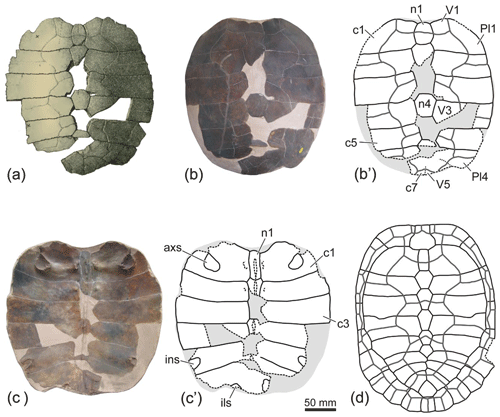
Figure 5Carapace of the podocnemidid turtle Apeshemys aegyptiaca comb. nov. (Erymnochelyini), from the lower Miocene (Burdigalian) of the Qattara Depression (Matruh Governorate, northern Egypt). (a–c) Type specimen. (a) Drawing of the dorsal view of the carapace, corresponding to fig. 1 on plate 1 of Andrews (1900). (b–c) Carapace of the plaster cast NHMUK R2927, corresponding to the holoplastotype of the specimen, in dorsal (b) and ventral (c) views. (d) Dorsal view of a shell of another specimen, currently lost, based on fig. 21 of Fourteau (1920). It is important to point out that some details of this drawing were erroneous, such as the low number of peripherals.
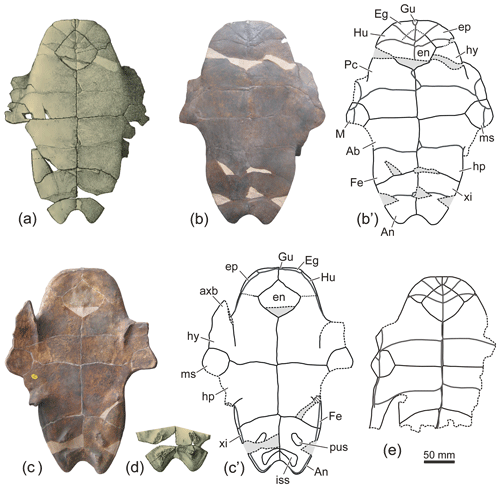
Figure 6Plastron of the podocnemidid turtle Apeshemys aegyptiaca comb. nov. (Erymnochelyini), from the lower Miocene (Burdigalian) of the Qattara Depression (Matruh Governorate, northern Egypt). (a–d) Type specimen. (a) Drawing of the ventral view of the plastron, corresponding to fig. 2 on plate 1 of Andrews (1900). (b–c) Plastron of the plaster cast NHMUK R2927, corresponding to the holoplastotype of the specimen, in ventral (b) and dorsal (c) views. (d) Drawing of the dorsal view of the posterior area of the posterior plastral lobe, corresponding to fig. 3 on plate 1 of Andrews (1900). (e) Ventral view of the partial plastron of another shell, currently lost, based on fig. 21 of Fourteau (1920).
Type and only included species
Apeshemys aegyptiaca (Andrews, 1900).
Etymology
This generic name is composed of the prefix Apesh-, an Egyptian turtle-headed god associated with the darkness, and the suffix -emys (Greek), referring to freshwater turtle.
Type locality and horizon
Moghra Oasis, Qattara Depression, Matruh Governorate, northern Egypt. Moghra Formation, early Miocene (Burdigalian) (Andrews, 1900; Gaffney et al., 2011; Pérez-García et al., 2017).
Distribution
Early Miocene of the Qattara Depression, Egypt.
Diagnosis
As for the type and only known species.
-
Apeshemys aegyptiaca (Andrews, 1900) comb. nov.
Figs. 5–6
-
Podocnemis aegyptiaca Andrews (1900), Dacqué (1912), Fourteau (1920)
-
Erymnochelys aegyptiaca Williams (1954), Broin (1977)
-
aff. Erymnochelys aegyptiaca Lapparent de Broin (2000)
-
“Podocnemis” aegyptiaca Gaffney et al. (2011), Pérez-García et al. (2017), Pérez-García (2019), Lapparent de Broin et al. (2020)
Type material
Andrews (1900) figured a shell that he identified as the type specimen of this species (see Figs. 5a, 6a, d; fig. 2C in plate 1 of Andrews, 1900), by drawings corresponding to the dorsal surface of the carapace, the ventral surface of the plastron and most of the xiphiplastral dorsal surface. This specimen is currently lost. An artificial mold of the type specimen is identified here, NHMUK R2927 (Figs. 5b–c, 6b–c), designated as the holoplastotype (see Evenhuis, 2008, and references therein).
Other specimens attributed to this taxon
Despite the fact that Andrews (1900) and Fourteau (1920) alluded to the presence of more specimens attributable to this species, from the type locality and area, only a second shell belonging to it has so far been analyzed and figured, by schematic drawings (see Figs. 4d, 6e; fig. 21 of Fourteau, 1920). This specimen is currently lost. Some specimens found there in 1900 and deposited in the NHMUK are compatible with this species, being recognized here as cf. Apeshemys aegyptiaca: an almost complete third right costal, showing a sinuous margin of the third vertebral, compatible with the lateral rounded protrusion that characterizes the third vertebral of this species (see Diagnosis) (NHMUK R2961; Fig. 7a–b); a partial and articulated anterior plastral lobe, in which the medial contact of the extragulars is recognized, which represents an exclusive character for Erymnochelyini within Podocnemididae (see Discussion), this group being exclusively known by Apeshemys aegyptiaca in the early Miocene record (NHMUK R2960; Fig. 7c–d), and sharing with this species the presence of a narrow dorsal expansion of the pectoral scutes (see Diagnosis).
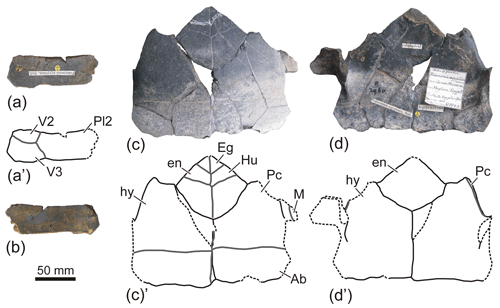
Figure 7Shell remains attributable to cf. Apeshemys aegyptiaca (Podocnemididae, Erymnochelyini), from the lower Miocene (Burdigalian) of the Qattara Depression (Matruh Governorate, northern Egypt). (a–b) NHMUK R2961, third right costal, in dorsal (a) and ventral (b) views. (c–d) NHMUK R2960, partial anterior plastral lobe, in ventral (c) and dorsal (d) views.
Diagnosis
Member of the lineage of Podocnemididae Erymnochelyini considering the medial contact of the extragulars, posteriorly to the reduced gular that they frame. It is defined by the following characters recognized as exclusive within this clade: second vertebral markedly wider than the third one; lateral rounded protrusions in the second and third vertebrals, anterior to the inter-pleural sulci. It shows the following unique combination of characters: absence of carapacial medial keel; six neurals; medial contact of the sixth to eighth pairs of costals; heptagonal first vertebral, with short latero-anterior margins, and wider than the nuchal; first pair of marginals overlapping on half of the nuchal lateral margins; absence of extragular protrusions; narrow dorsal expansion of the plastral scutes; anal length along the lateral xiphiplastral margin less than 2 times that of the femorals.
The medial contact of the extragulars, posteriorly to the reduced gular that they frame, represents a synapomorphy shared by the members of the lineage of Podocnemididae Erymnochelyini, which allowed the attribution of the early Oligocene “Podocnemis” fajumensis and the early Miocene “Podocnemis” aegyptiaca to it (see Pérez-García et al., 2021, and references therein). In addition to these two taxa, attributed here to the oldest genera of Erymnochelyini defined for the African record and the only ones identified in Egypt, this lineage is represented by three species of the European Eocene genus Eocenochelus Pérez-García, Lapparent de Broin and Murelaga, 2017 (i.e., the lower Eocene Eocenochelus lacombiana Pérez-García, Lapparent de Broin and Murelaga, 2017, the middle Eocene Eocenochelus eremberti (Broin, 1977), and the upper Eocene Eocenochelus farresi Pérez-García, Lapparent de Broin and Murelaga, 2017), as well as by three other African representatives: Kenyemys williamsi Wood, 1983 and Turkanemys pattersoni Wood, 2003, defined in the late Miocene of Kenya, and the extant Erymnochelys madagascariensis (Pérez-García et al., 2017) (Fig. 8). This group, of African origin, is known from the Upper Cretaceous record, having been recorded, for that geological epoch, by fragmentary remains from Niger, Sudan, and Madagascar (Lapparent de Broin, 2000). Its African record is relatively continuous from the Oligocene to the present, having been reported for all geological epochs (see Pérez-García et al., 2017, and references therein). A hitherto unpublished specimen from the lower or middle Eocene of Mali (oolitic limestone of the Tamaguélelt Formation; see O'Leary et al., 2019), corresponding to an isolated entoplastron that shares the above indicated Erymnochelyini synapomorphy (see Fig. 9), allows here filling in the gap for the African record of this lineage that existed between the Late Cretaceous and the Oligocene.
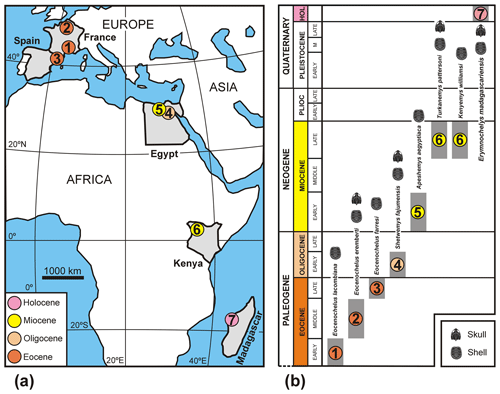
Figure 8Geographical (a) and stratigraphic (b) position of the type localities of all extinct representatives of Erymnochelyini (Pleurodira, Podocnemididae) currently known (1–6), and region where the only extant representative of this lineage lives (7): (1) Jonquières, Aude, France, Europe. Early Eocene. Type locality of Eocenochelus lacombiana. (2) Saint-Germain-en-Laye, Yvelines, France, Europe. Middle Eocene. Type locality of Eocenochelus eremberti. (3) Osona, Catalonia, Spain, Europe. Late Eocene. Type locality of Eocenochelus farresi. (4) North of Lake Qarun, Fayum Depression, Fayum Governorate, Egypt, Africa. Early Oligocene. Type locality of Shetwemys fajumensis comb. nov. (5) Moghra Oasis, Qattara Depression, Matruh Governorate, Egypt, Africa. Early Miocene. Type locality of Apeshemys aegyptiaca comb. nov. (6) Lothagam, southwest of Lake Turkana, Kenya, Africa. Late Miocene. Type locality of Kenyemys williamsi and Turkanemys pattersoni. (7) Western Madagascar, Africa, where the extant Erymnochelys madagascariensis lives. The identification of each taxon through the shell or through both the skull and the shell is indicated in (b). Panel (b) is modified from the fig. 1 of Pérez-García et al. (2017).

Figure 9NHMUK R9832, entoplastron of an indeterminate representative of Erymnochelyini (Pleurodira, Podocnemididae), from the lower or middle Eocene, found 25 km north-northeast of InTasit (Gao Region, Mali). (a) Ventral view. (b) Dorsal view.
The shell of all so far defined representatives of Erymnochelyini is known. Those of “Podocnemis” fajumensis and “Podocnemis” aegyptiaca show both autapomorphies and a unique combination of characters for each of them, which allows confirming the validity of both species (see Table 1). Thus, the new combinations Shetwemys fajumensis (Andrews, 1903) and Apeshemys aegyptiaca (Andrews, 1900) are proposed here.
Table 1Comparative shell characters between Shetwemys fajumensis comb. nov., Apeshemys aegyptiaca comb. nov., and all other representatives of Erymnochelyini (Pleurodira, Podocnemididae) currently known.
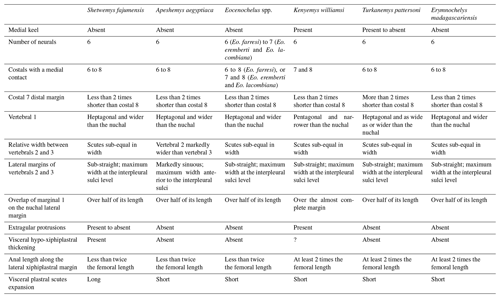
Table 2Comparative cranial characters between Shetwemys fajumensis comb. nov. and all other representatives of Erymnochelyini (Pleurodira, Podocnemididae) in which this anatomical region is known.
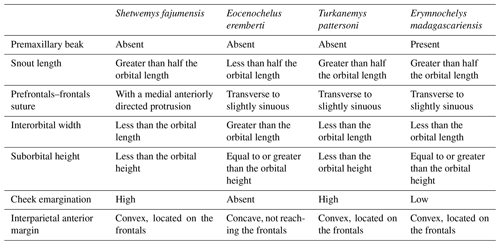
Shetwemys fajumensis and A. aegyptiaca lack the medial keel present in the carapace of K. williamsi and in some specimens of T. pattersoni (Figs. 2a, g; 5a–b). Shetwemys fajumensis and A. aegyptiaca share the presence of six neurals with all representatives of Erymnochelyini except with Eo. eremberti and Eo. lacombiana, whose neural series are composed of seven plates (Figs. 2a–b, g–h; 5a–b, d). The contact between the sixth, seventh and eighth pairs of costals observed in S. fajumensis and A. aegyptiaca is shared with the other representatives of Erymnochelyini except with Eo. eremberti, Eo. lacombiana and K. williamsi, in which only the last two pairs of costals have a medial contact (Figs. 2a–b, g–h; 5d). The presence of very short distal margins of the seventh costals, more than 2 times shorter than those of the eighth ones, is not shared with either of the two species analyzed here (Figs. 2a; 5d), representing an autapomorphy of T. pattersoni.
Shetwemys fajumensis and A. aegyptiaca share with almost all the representatives of Erymnochelyini the presence of a heptagonal first vertebral, with short latero-anterior margins, this scute being wider than the nuchal plate (Figs. 2a; 3a, 5b, d). Only K. williamsi does not share these characters, its first vertebral being narrower and pentagonal. The presence of a second vertebral markedly wider than the third one is unique to A. aegyptiaca within Erymnochelyini (Fig. 5a–b, d). Furthermore, the markedly sinuous morphology of the margin of those scutes with the adjacent pleurals, as well as the presence of lateral rounded protrusions in those vertebrals, located anterior to the inter-pleural sulci, is also unique to this species. The presence of an overlap of the first pair of marginals on about half of the length of the nuchal lateral margins, observed in S. fajumensis and A. aegyptiaca (Figs. 2a; 3a; 5d), is shared with the other representatives of Erymnochelyini except for K. williamsi, which shows a much greater overlap.
The presence of well-developed extragular protrusions in some specimens of S. fajumensis is shared with K. williamsi (Figs. 1a–b, 4c–d). These structures have not been identified in other specimens of S. fajumensis or in any other species of Erymnochelyini (Figs. 3e–f, h–i; 4a–b, e–f, g–j; 6a–c, e). The presence of a marked increase in thickness in the visceral region of the plastron of S. fajumensis, in the contact region between the hypoplastra and the xiphiplastra, is not shared with any other member of Erymnochelyini (Fig. 3g).
The length of the gular scute has been used to characterize some members of Erymnochelyini, being identified as relatively long (i.e., reaching the anterior margin of the entoplastron or overlying the anterior region of this plate) in Eocenochelus sp., but relatively short (i.e., not reaching that plate) in K. williamsi and Er. madagascariensis (Pérez-García et al., 2017). However, these two character states are observed here as forming part of the intraspecific variability of both S. fajumensis and A. aegyptiaca (Figs. 1a; 3e, h; 4a, c, g, i; 6a–b, e), as occurs for T. pattersoni (Pérez-García et al., 2017). The presence of relatively short anal scutes in S. fajumensis and A. aegyptiaca, less than 2 times the femoral length along the lateral xiphiplastral margin, is shared with Eocenochelus spp. but not with K. williamsi, T. pattersoni and Er. madagascariensis (Figs. 3e, h; 4n; 6a–b). Shetwemys fajumensis differs from all other members of Erymnochelyini due to the presence of a broad dorsal expansion of the plastral scutes (Figs. 1b; 3f, i; 4b, d, f, h, j, m).
Only the skull of some representatives of Erymnochelyini is known. In addition to S. fajumensis, they are Eo. eremberti, T. pattersoni and Er. madagascariensis. As with the shell, the character combination recognized for the skull of S. fajumensis is identified as exclusive for this species (see Table 2; figs. 42–46 in Gaffney et al., 2011).
The absence of premaxillary beak in S. fajumensis is shared with Eo. eremberti and T. pattersoni, but not with Er. madagascariensis. Shetwemys fajumensis shares with T. pattersoni and Er. madagascariensis, but not with Eo. eremberti, the presence of a snout length greater than half the length of the orbits. The presence of an anteriorly directed and well-developed medial protrusion in the suture between the prefrontals and the frontals of S. fajumensis is not present in any other member of Erymnochelyini. The width of the interorbital space less than the maximum length of the orbits is shared between S. fajumensis, T. pattersoni and Er. madagascariensis, differing from the condition in Eo. eremberti. A height of the orbits markedly higher than that of the maxilla below them is present in S. fajumensis and T. pattersoni, but not in Eo. eremberti and Er. madagascariensis. The presence of a high cheek emargination in S. fajumensis and T. pattersoni, exceeding the ventral margin of the orbit, contrasts with its lesser development in Er. madagascariensis and, especially, with the absence of this structure in Eo. eremberti. A convex anterior margin of the interparietal scute is shared between S. fajumensis, T. pattersoni and Er. madagascariensis, contrasting with the medial concavity present in that of Eo. eremberti. In fact, the interparietal scute of Eo. eremberti is the only one that does not reach the frontals, those of the other taxa overlapping the posterior region of these bones.
New information on the poorly known shells of two podocnemidid turtles from Egypt, attributable to Erymnochelyini, is provided here. They are the early Oligocene (Rupelian) “Podocnemis” fajumensis, from the Fayum Depression (Fayum Governorate), and the early Miocene (Burdigalian) “Podocnemis” aegyptiaca, from the Qattara Depression (Matruh Governorate).
Although several shell remains attributable to “Podocnemis” fajumensis were referred to in the literature, no photograph had been published so far. In fact, its holotype, corresponding to an anterior plastral lobe, was exclusively known through a schematic drawing. That specimen is currently identified as lost. A neotype is designated here for the species. Numerous shell remains of “Podocnemis” fajumensis, most of them corresponding to articulated elements (including a complete carapace and two complete plastra), are figured here in detail. Their study allows characterization of the complete anatomy of the shell of this taxon. The information on this anatomical region, together with that previously published on its skull, allows me to propose a new diagnosis for this taxon, in which a unique combination of characters, as well as autapomorphies, are considered. The attribution of “Podocnemis” fajumensis to the genus Podocnemis is not currently accepted, this genus being restricted to the northern area of South America. The genus Shetwemys is defined here, the new combination Shetwemys fajumensis being proposed.
“Podocnemis” aegyptiaca was considered a problematic taxon. This was because both the shell corresponding to its holotype and a second shell attributable to it, also represented by a schematic drawing published more than a century ago, are missing. A cast of its holotype has been found and is analyzed here, being identified as its holoplastotype. Its analysis allows me to confirm the characters used to recognize these specimens from the early Miocene of Egypt as attributable to a valid new species. In fact, the study of this specimen allows characterization of this taxon with more precision, a new diagnosis being proposed, in which both autapomorphies and an exclusive combination of characters are considered. The new genus Apeshemys is defined for this putative species of Podocnemis, the new combination Apeshemys aegyptiaca being proposed. The attribution of other unpublished specimens from its type locality and horizon to cf. Apeshemys aegyptiaca, also found more than a century ago, is performed.
The new Shetwemys and Apeshemys correspond to the two oldest genera of Erymnochelyini defined for the African record. Shetwemys fajumensis and Apeshemys aegyptiaca are the only members of this lineage identified in Egypt.
No data sets were used in this article.
The contact author has declared that there are no competing interests.
Publisher’s note: Copernicus Publications remains neutral with regard to jurisdictional claims in published maps and institutional affiliations.
The author thanks Sandra D. Chapman (NHMUK), Eugene S. Gaffney (AMNH), Carl Mehling (AMNH), and Rainer Schoch (SMNS) for access to the specimens studied here and the editor, Torsten Scheyer, and the reviewers, Sandra D. Chapman and Ignacio J. Maniel, for comments and suggestions.
This research has been funded by the Ministerio de Ciencia e Innovación (grant no. PID2019-111488RB-I00).
This paper was edited by Torsten Scheyer and reviewed by Ignacio J. Maniel and Sandra D. Chapman.
Andrews, C. W.: On a new species of chelonian (Podocnemis aegyptica) from the Lower Miocene of Egypt, Geol. Mag., 7, 1–2, 1900.
Andrews, C. W.: On some pleurodiran chelonians from the Eocene of the Fayum, Egypt, Ann. Mag. Nat. Hist., 11, 115–122, 1903.
Batsch, G. C.: Versuch einer Anleitung, zur Kenntniß und Geschichte der Thiere und Mineralien, Akademie Buchhandlung, 1788.
Bergounioux, F. M.: Les Chéloniens fóssiles des terrains tertiaires del Vénétie, Memoire degli istituti di Geologica e Mineralogia dell'Università di Padova, 18, 1–115, 1954.
Boettger, O.: Katalog der Reptilien-Sammlung im Museum der Senckenbergischen Naturforschenden Gesellschaft in Frankfurt am Main. I. Teil (Rhynchocephalen, Schildkröten, Krokodile, Eidechsen, Chamäleons), Gebrüder Knauer, Frankfurt, 1893.
Cope, E. D.: On the limits and relations of the Raniformes, P. Acad. Nat. Sci. Phila., 16, 181–183, 1864.
Cope, E. D.: On the origin of genera, P. Acad. Nat. Sci. Phila., 20, 242–300, 1868.
Cornalia, E.: Vertebratorum synopsis in Museo Mediolanense extantium quae per novum Orbem Cajetanas Osculati collegit Annis 1846-47-48. Speciebus novis vel minus cognitus adjectis, nec non Descriptionibus atque Iconibus Illustratis, curante Aemilio Cornalia, Mediolani, Museum Mediolanense, Milan, 1849 (in Latin).
Dacqué, E.: Die fossilen Schildkröten Aegyptens, Neues Jahrb. Geol. P.-M., 14, 275–337, 1912.
de Broin, F.: Contribution à l'étude des Chéloniens. Chéloniens continentaux du Crétacé et du Tertiaire de France, Mem. Mus. Nat. Hist. Nat., 38, 1–366, 1977.
de Broin, F.: Les tortues et le Gondwana. Examen des rapports entre le fractionnement du Gondawana et la dispersión géographique des tortues pleurodires à partir du Crétacé, Studia Geologica Salmanticensia-Studia Palaeocheloniologica, 2, 103–142, 1988.
de Lapparent de Broin, F.: African chelonians from the Jurassic to the Present: Phases of development and preliminary catalogue of the fossil record, Palaeontologia Africana, 36, 43–82, 2000.
de Lapparent de Broin, F., Chirio, L., and Bour, R.: The oldest erymnochelyine turtle skull, Ragechelus sahelica n. gen., n. sp., from the Iullemmeden basin, Upper Cretaceous of Africa, and the associated fauna in its geographical and geological context, Geodiversitas, 42, 455–484, https://doi.org/10.5252/geodiversitas2020v42a25, 2020.
Dollo, L.: Podocnemis congolensis, tortue fluviatile nouvelle du Montien (Paléocène inférieur) du Congo et l'évolution des chéloniens fluviátiles, Ann. Mus. Congo Belge, A3, 49–65, 1913.
Duméril, A. M. C.: Description des reptiles nouveaux ou imparfaitement connus de la collection du Muséum d'Histoire Naturelle, et remarques sur la classification et les charactères des reptiles, Archs. Mus. Hist. nat. Paris, 6, 209–264, 1852.
Evenhuis, N. L.: A compendium of zoological type nomenclature: a reference source, Bishop Museum Technical Report, 41, 1–23, 2008.
Ferreira, G. S., Bronzati, M., Langer, M. C., and Sterli, J.: Phylogeny, biogeography and diversification patterns of side-necked turtles (Testudines: Pleurodira), R. Soc. Open Sci., 5, 171773, https://doi.org/10.1098/rsos.171773, 2018.
Fourteau, R.: Contribution à l'étude des vertébrés miocènes de l'Egypte, Government Press, Cairo, 1920.
Gaffney, E. S. and Forster, C. A.: Side-necked turtle lower jaws (Podocnemididae, Bothremydidae) from the Late Cretaceous Maevarano Formation of Madagascar, Am. Mus. Novitates, 3397, 1–13, 2003.
Gaffney, E. S., Tong, H., and Meylan, P. A.: Evolution of the side-necked turtles: the families Bothremydidae, Euraxemydidae, and Araripemydidae, B. Am. Mus. Nat. Hist., 300, 1–700, https://doi.org/10.1206/350.1, 2006.
Gaffney, E. S., Meylan, P. A., Wood, R. G., Simons, E., and de Almeida Campos, D.: Evolution of the side-necked turtles: the family Podocnemididae, Am. Mus. Nat. Hist., 350, 1–237, 2011.
Georgalis, G. L., Zoboli, D., Pérez-García, A., Pillola, G. L., and Delfino, M.: The occurrence of Eocenochelus (Testudines, Pleurodira) from Sardinia supports palaeogeographic reconstruction of the proximity of the island to continental Western Europe during the Eocene, Riv. It. Paleontol. Strat., 126, 833–846, https://doi.org/10.13130/2039-4942/14443, 2020.
Grandidier, A.: Liste des reptiles nouveaux découverts, en 1866, sur la côte sud-ouest de Madagascar, Revue et Magasin de Zoologie Pure et Appliquée, 19, 232–234, 1867.
Müller, L.: Über eine neue Podocnemis-Art (Podocnemis vogli) aus Venezuela nebst ergänzenden Bemerkungen über die systematischen Merkmale der ihr nächstverwandten Arten, Zool. Anz., 110, 97–109, 1935.
O'Leary, M., Bouaré, M. L., Claeson, K. M., Hill, R. V., McCartney, J., Sessa, J. A., Sissoko, F., Tapanila, L., Wheeler, E., and Roberts, E. M.: Stratigraphy and paleobiology of the Upper Cretaceous–Lower Paleogene sediments from the trans-Saharan seaway in Mali, B. Am. Mus. Nat. Hist., 436, 1–177, 2019.
Pérez-García, A.: New information and establishment of a new genus for the Egyptian Paleogene turtle “Stereogenys” libyca (Podocnemididae, Erymnochelyinae), Hist. Biol., 31, 383–392, https://doi.org/10.1080/08912963.2017.1374383, 2019.
Pérez-García, A. and Chapman, S. D.: Identification of Podocnemididae (Pleurodira) in the British record by the first specimen of the coastal Eocenochelus recognized outside Continental Europe, P. Geologists Assoc., 128, 757–763, https://doi.org/10.1016/j.pgeola.2017.06.001, 2017.
Pérez-García, A. and de Lapparent de Broin, F.: New insights into the anatomy and systematic of “Papoulemys” laurenti, a representative of Neochelys (Chelonii, Podocnemididae) from the early Eocene of the south of France, Palaontol. Z., 89, 901–923, https://doi.org/10.1007/s12542-015-0259-3, 2015.
Pérez-García, A. and Smith, T.: Identification of the African–European Erymnochelys group (Pleurodira, Podocnemididae) in the Belgian fossil record: first finding of Eocenochelus eremberti outside its type locality, Foss. Rec., 20, 245–251, https://doi.org/10.5194/fr-20-245-2017, 2017.
Pérez-García, A., de Lapparent de Broin, F., and Murelaga, X.: The Erymnochelys group of turtles (Pleurodira, Podocnemididae) in the Eocene of Europe: new taxa and paleobiogeographical implications, Palaeontol. Electron., 20.1.14A, 1–28, https://doi.org/10.26879/687, 2017.
Pérez-García, A., Mees, F., and Smith, T.: Shell anatomy of the African Paleocene bothremydid turtle Taphrosphys congolensis and systematic implications within Taphrosphyini, Hist. Biol., 32, 376–385, https://doi.org/10.1080/08912963.2018.1497023, 2020.
Pérez-García, A., Díaz-Berenguer, E., Badiola, A. and Canudo, J. I.: An unexpected finding: identification of the first complete shell of the Franco-Belgian middle Eocene littoral pleurodiran turtle Eocenochelus eremberti in Spain, Hist. Biol., 33, 527–533, https://doi.org/10.1080/08912963.2019.1644330, 2021.
Rhodin, A. G. J., Iverson, J. B., Bour, R. Fritz, U., Georges, A., Shaffer, H. B., and van Dijk, P. P.: Turtles of the World: Annotated Checklist and Atlas of Taxonomy, Synonymy, Distribution, and Conservation Status (8th Ed.), Chelonian Research Monographs, 7, 1–292, https://doi.org/10.3854/crm.7.checklist.atlas.v8.2017, 2017.
Schmidt, K. P.: A fossil turtle from Peru, Field Mus. Nat. Hist., Geol. ser., 4, 251–254, 1931.
Schmidt, K. P.: A new turtle of the genus Podocnemis from the cretaceous of Arkansas, Field Mus. Nat. Hist., Geol. Ser., 8, 1–12, 1940.
Schweigger, A. F.: Prodromus Monographiae Cheloniorum, Königsberger Archiv für Naturwissenschaft und Mathematik, 1, 271–368, 406–458, 1812.
Siebenrock, F.: Zur Systematik der Schildkröten-Gattung Podocnemis Wagler. Sitzungsberichte der Kaiserlichen Akademie der Wissenschaften in Wien, Mathematisch-Naturwissenschaftliche Klasse, 111, 157–170, 1902.
Suárez, J. M.: Um quelônio da Formação Baurú, in: Anais do XXIII Congresso Brasileiro de Geologia, Salvador, 167–176, 1969.
Troschel, F. H.: Amphibien, in Reisen in Britisch-Guiana in den Jahren 1840–44. Im Auftrage Majestät des Königs von Preussen ausgeführt. Versuch einer Zusammenstellung der Fauna und Flora von Britisch-Guiana, Leipzig, Weber, 645–661, 1848.
von Reinach, A.: Vorläufige Mitteilung über neue Schildkröten aus dem ägyptischen Tertiär, Zool. Anz., 26, 459–463, 1903a.
von Reinach, A.: Schildkrötenreste aus dem ägyptischen Tertiär, Abh. Senckenb. Naturforsch. Ges., 29, 1–64, 1903b.
von Spix, J. B.: Animalia nova, species novae Testudinum et Ranarum quas in itinere per Brasiliam annis 1817–1820 collegit et descripsit, Hübschmann, Munich, 1824.
Wagler, J.: Natürliches System der Amphibien, mit Vorangehender Classification der Säugethiere und Vögel, Cotta, Munich, 1830.
Walker, C. A.: Podocnemis somaliensis, a new pleurodiran turtle from the middle Eocene of Somalia, Palaeontology, 9, 511–516, 1966.
Williams, E. E.: New or redescribed pelomedusid skulls from the Tertiary of Africa and Asia (Testudines, Pelomedusidae). 2. A podocnemide skull from the Miocene of Moghara, Egypt, Breviora, 39, 1–8, 1954.
Williams, E. E.: Podocnemis bassleri, a new species of pelomedusid turtle from the Late Tertiary of Peru, Am. Mus. Novitates, 1782, 1–10, 1956.
Wood, R. C.: Kenyemys williamsi, a fossil pelomedusid turtle from the Pliocene of Kenya, in: Advances in herpetology and evolutionary biology, Museum of Comparative Zoology, Cambridge, 74–85, 1983.
Wood, R. C.: Fossil turtles from Lothagam, in: Lothagam: the dawn of humanity in eastern Africa, Columbia University Press, New York, 115–136, 2003.
Wood, R. C. and Díaz de Gamero, M. L.: Podocnemis venezuelensis, a new fossil pelomedusid (Testudines, Pleurodira) from the Pliocene of Venezuela and a review of the history of Podocnemis in South America, Breviora, 376, 1–23, 1971.
Podocnemisfajumensis and the early Miocene
Podocnemisaegyptiaca are two podocnemidid pleurodiran turtles from northern Egypt, defined more than a century ago. Both species are confirmed as valid. They are attributed to two new genera, corresponding to the oldest defined for the African record of Erymnochelyini. Thus, the new combinations Shetwemys fajumensis and Apeshemys aegyptiaca are proposed.
Podocnemisfajumensis and the early Miocene
Podocnemisaegyptiaca are two...




